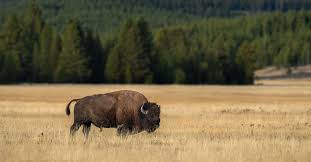In a recent incident at Yellowstone National Park, a tourist was caught on video engaging in unsafe behavior by taunting a wild bison. This reckless act serves as a stark reminder of the importance of respecting wildlife and adhering to park regulations to ensure safety for both visitors and animals alike.
Details of the Incident
On July 24, a man approached a grazing bison within dangerous proximity, breaking park protocol for a fleeting moment of notoriety that could have had dire consequences. The bison, which can charge at speeds of up to 30 miles per hour, appeared agitated by the intrusion and positioned itself directly in front of the man, staring him down with intense scrutiny. The video of this encounter, recorded by passersby, quickly gained traction online, igniting discussions about wildlife safety.
As the confrontation unfolded, a bystander questioned whether the bison was being provoked: “Is he calling him out?” The thrill-seeker, upon sensing danger, backed away swiftly, nearly stumbling over a log in his retreat. After ensuring his safety, he mistakenly proclaimed, “It was really close, man. I think it liked me, actually,” which trivializes the serious nature of the scenario.
The Necessity of Wildlife Protocols
Park officials strongly advise campers and visitors to maintain a distance of at least 25 feet from roaming bisons, urging against provocative behavior towards these majestic creatures. Unfortunately, the unidentified man in the footage disregarded this warning not just once, but twice, as he attempted to incite a reaction from the bison a second time.
Consequences for Ignoring Protocol
This incident is not isolated; it highlights a troubling trend where tourists interject themselves into wildlife’s space. Already this year, separate incidents involving a couple of men—one from New Jersey and another from Florida—resulted in serious injuries when they approached bisons too closely. These occurrences raise red flags regarding tourist conduct in national parks, leading to calls for stronger enforcement of wildlife conservation laws.
A Glimpse into the History of Wildlife Conservation at Yellowstone
Established in 1872, Yellowstone National Park was the first national park on the globe, born out of a growing awareness and desire to protect natural habitats and wildlife. Following years of rampant overhunting and habitat loss, national parks emerged as havens for diverse ecosystems and species. The reintroduction of wolves into the park in 1995 and various conservation efforts have demonstrated the delicate balance necessary for sustaining wildlife populations and maintaining biodiversity in the area.
Over the years, key conservation figures, including naturalist John Muir and President Theodore Roosevelt, have shaped the ethos surrounding wildlife protection. Their legacy remains relevant, underscoring the necessity for preservation efforts and responsible tourism that honors the natural environment. As a result, Yellowstone is a cornerstone of wildlife tourism, offering opportunities for visitors to experience nature while emphasizing respect for the park’s indigenous inhabitants.
Importance of Respecting Wildlife for Sustainable Tourism
The juxtaposition of thrill-seeking and respect for wildlife presents a paradox faced by modern tourism. Popular destinations like Yellowstone rely on visitor interest in nature, which ultimately sustains their existence and conservation efforts. Thus, a fundamental ethical question emerges: How can tourists engage with wildlife without compromising the safety and integrity of the ecosystem?
Educating tourists about proper protocols and the potential dangers of disturbing wildlife is essential for fostering a sustainable tourism model. Encouraging visitors to engage with the environment responsibly ensures that parks can remain attractions without degrading their natural settings. Many national parks around the world have implemented successful educational programs that promote awareness about wildlife safety.
The Role of National Parks in Ecotourism
Until recent years, preservation efforts in many national parks had leaned heavily on protecting the areas from human influence, although the advent of ecotourism has shifted perspectives. This approach advocates for responsible travel that supports conservation and minimizes environmental footprints. Wildlife encounters are at the heart of ecotourism, where interactions between tourists and nature are both enriching and enlightening.
Key Benefits of Ecotourism:
- Increased Wildlife Awareness: Engaging tourists through informative programs fosters appreciation for wildlife.
- Economic Support for Preservation: Ticket sales and park revenues contribute to sustaining local ecosystems.
- Promoting Responsible Behavior: Educating visitors on sustainability encourages them to act as stewards of the land.
Challenges and Considerations
Despite efforts to promote ecotourism and wildlife preservation, challenges remain. Managing visitor numbers, educating tourists, and the potential for human-wildlife conflicts require ongoing attention from park services and stakeholders. The balance between access and conservation is delicate, but essential for maintaining the natural beauty and ecological significance of areas like Yellowstone.
In summary, the disconcerting incident involving a tourist taunting a bison in Yellowstone highlights significant concerns regarding wildlife interactions and tourism practices. As visitors flock to such landmarks for adventure and stunning views, it is imperative that they recognize their responsibilities to the environment. To ensure these natural wonders remain intact for generations to come—embracing initiatives that prioritize ecological sustainability is essential.
Destinations like Yellowstone offer the opportunity to connect with nature through activities such as hiking, wildlife watching, and camping, all while renting boats and accessing nearby lakes for various outdoor adventures. For those intrigued by the marine side of tourism, GetBoat.com serves as an international marketplace for renting sailing boats and yachts, catering to a diverse range of tastes and budgets. Keeping up with tourism news is crucial for crafting responsible travel experiences.

 Reckless Tourist’s Encounter with Bison at Yellowstone">
Reckless Tourist’s Encounter with Bison at Yellowstone">
